

Brazil’s electronic-music industry: So much more than samba. AS RIO DE JANEIRO clears up after Carnival, it is not only the sound of samba that is subsiding.
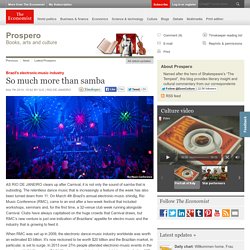
The relentless dance music that is increasingly a feature of the week has also been turned down from 11. On March 4th Brazil’s annual electronic-music shindig, Rio Music Conference (RMC), came to an end after a two-week festival that included workshops, seminars and, for the first time, a 32-venue club week running alongside Carnival. Clubs have always capitalised on the huge crowds that Carnival draws, but RMC’s new venture is just one indication of Brazilians’ appetite for electro music and the industry that is growing to feed it. When RMC was set up in 2009, the electronic dance-music industry worldwide was worth an estimated $3 billion. It's now reckoned to be worth $20 billion and the Brazilian market, in particular, is set to surge. Electronic music is not new to Brazil, but the country's authorities have been slow to recognise its potential.
Sadly this party culture has an underside. Brazilian underground music - Google Search. Hip-Hop Brazil: 13 Brazilian Rap Artists Who Made History. By now, just about every country on earth is represented on Planet Hip-Hop, but few loom as large as Brazil.
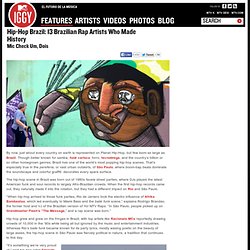
Though better known for samba, funk carioca, forro, tecnobrega, and the country’s billion or so other homegrown genres, Brazil has one of the world’s most popping hip-hop scenes. That’s especially true in the pereferia, or vast urban outskirts, of São Paulo, where boom-bap beats dominate the soundscape and colorful graffiti decorates every spare surface. The hip-hop scene in Brazil was born out of 1980s favela street parties, where DJs played the latest American funk and soul records to largely Afro-Brazilian crowds. When the first hip-hop records came out, they naturally made it into the rotation, but they had a different impact on Rio and São Paulo. Hip-hop grew and grew on the fringes in Brazil, with top artists like Racionais MCs reportedly drawing crowds of 10,000 in the ‘90s while being all but ignored by the music and entertainment industries. 1. 2. 3. 5. 6. 7. 8. 9. 10.
Generation Bass. Amon Tobin / Artists / Ninja Tune. Amon Tobin On Ninja Tune Brazilian-born Amon Tobin first emerged between 1994-1995 with a string of 12" singles on a small London-based record label called 9Bar Records.
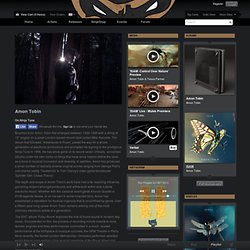
The album that followed, 'Adventures In Foam', paved the way for a whole generation of electronic productions and prompted his signing to the prodigious Ninja Tune in 1996. He has since gone on to record seven critically- acclaimed albums under his own name on Ninja that have since helped define the label as a force in musical innovation and diversity. In addition, Amon has produced a small number of radically diverse original scores ranging from George Palfi's cult cinema oddity 'Taxidermia' to Tom Clancy's video game blockbuster 'Splinter Cell: Chaos Theory'.
The depth and scope of Amon Tobin's work have had a far-reaching influence, garnering respect amongst producers and artists both within and outside electronic music. The 2007 album 'Foley Room' explored the role of found sound in modern day music. Amon Tobin. Amon Adonai Santos de Araújo Tobin (born February 7, 1972), known as Amon Tobin, is a Brazilian musician, composer and producer of electronic music.[1] He is described as a virtuoso sound designer[2] and is considered to be one of the most influential electronic music artists in the world.[3] He is noted for his unusual methodology in sound design and music production.
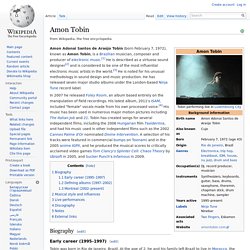
He has released seven major studio albums under the London-based Ninja Tune record label. Biography[edit] Early career (1995–1997)[edit] Under his original moniker Cujo (in Portuguese, the word for whose), he released a series of original compositions on 12-inch vinyl.[8] AllMusic called them "head-turning" in a review.[9] Many of those tracks were later included on his first full-length album Adventures in Foam, originally released in 1996 by Ninebar to a limited release of 5,000 copies.[10] Defining albums (1997–2002)[edit] Montreal (2002–present)[edit]
Funk carioca. Funk carioca, favela funk and, elsewhere in the world, baile funk, is a type of dance music from Rio de Janeiro, derived from Miami bass.[1][2] "Baile funk", in Brazil, refers not to the music, but to the actual parties or discothèques in which the music is played.[3] Although originated in Rio, funk carioca has become increasingly popular amongst working classes in other parts of Brazil.
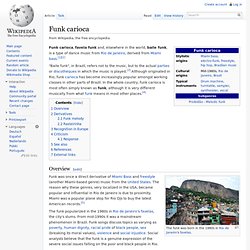
In the whole country, funk carioca is most often simply known as funk, although it is very different musically from what funk means in most other places.[4] Overview[edit] Funk was once a direct derivative of Miami Bass and freestyle (another Miami-based genre) music from the United States. The reason why these genres, very localized in the USA, became popular and influential in Rio de Janeiro is due to proximity.
Derivatives[edit] There are some derivatives and different music expressions of funk carioca.